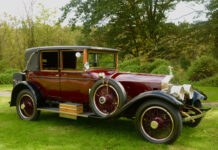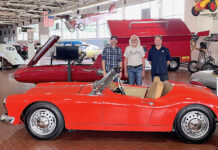By Jay Hirsch
Rob and Debbie Freeman had a dream that came to fruition in the form of their 1956 “Berlin Buick.” That Bug is now a mid-engine-American “hot” Hot Rod, with a 215 cid Buick V-8 mounted where the rear seat once was. All the work done on the VW was performed by Browns Metal Mods of Port Leyden, NY.
What was supposed to be “only a chop of the top” turned into a two-year build. From talking with Gary Brown and listening to what Gary said, Rob knew that what he and Debbie envisioned for the VW in the 15 years they owned the car could be executed by Gary and his brothers. They were on the same wavelength and the clincher was when Gary suggested using a 215 cid Buick V-8 engine. That was the engine Rob had in his mind to use if he ever did a total rebuild of the VW. The results of that “meeting of the minds” and long talk are seen here,.
The aluminum 1961–1963 215 Buick V-8 has been the engine many people have used when rebuilding a car that was under-powered when new but also had a small engine compartment for a replacement engine with power. The 215 engine’s relatively light-weight for the power it puts out is also a plus; the engine weighs 315 pounds. Unfortunately, Buick sold the rights of the engine to Rover of England in 1967. The 215 V-8 is still the basis for Rover’s V-8 of today
The VW has a custom-built tube chassis that rides on a custom independent suspension with Ride Tech air shocks.
The aluminum 215 V-8 in Rob’s VW has had some “enhancements,” done by Jack Dineen, with custom flat top pistons and a compression ratio of 12.5:1.
As for the body of the VW, the design is Rob’s in collaboration with Brown. The top with its sunroof was chopped 4.5 inches. Roll pans were fabricated for the front and back, and the rolled fenders were left their stock width. The rear-engine lid (remember the Beetle was an air-cooled rear-engine car) and front trunk were smoothed and peaked.
The doors were rounded and converted to rear hinges and are opened electrically and the running boards eliminated. The bumpers were split and narrowed and tucked into the body. The exhaust exits via straight headers into 1953 Buick venti-port portholes under the rear windows.
Incorporated into the inside of the car is a roll cage and fire system. The dash from a 1949 Buick was sectioned to fit the smaller VW, with the shift knob and shifter boot bezel being handcrafted. The steering wheel was cut down from a 1949 Buick to fit the VW stock ring. The stock VW seats were cut for clearance and were covered in beige leather originally. When Debbie saw the beige leather seats at the auto upholstery shop, she called Rob and said “no beige leather, the interior colors have to reflect the colors of the car!’ Debbie found the color of the leather and had the fabric cut and designed for the seat back and interior of the car,
The gas is delivered to the engine with Hilborn stack fuel injection utilizing a Holley EFI system, and MSD Billet distributor and MSD coil provides the spark control To keep the engine cool (and “kool”) are twin Davies Craig water pumps mated to twin radiators.
In place of the weak VW transaxle, the car has a Mendola four-speed adapted to the Buick engine and a driveshaft made with eight-inch 930 CV drive axles. The VW rides on 145SR x 15 tires up front and 345/50S x 15 tires on the rear with the body being tubbed by Browns to accommodate those “fat” tires. To stop the VW, four-wheel-disc-brakes have been added to the car. To set off the body of the VW a two-tone paint scheme of PPG Tonic Brown and Ginger Beer are used. Separating the Tonic Brown top of the body from the Ginger Brown bottom is a 1957 Buick side sweep spear.
The name “Berlin Buick” refers to the bloodline’s of the car. The “Buick” refers to the engine and many trim items from Buick. The “Berlin” is the German heritage of the 1956 Volkswagen Beetle body.
“‘German Buick’ does not have the sound ‘Berlin Buick’ has,” said Rob
As for the ride and handling, in a word it is a blast! The fat rear tires handle all the power the engine puts out and keep the car glued to the road. The air shocks make for a smooth but firm ride and with the sunroof slid back there is the top-down-feel-of a convertible on a warm summer day. The sound of the engine behind you in the passenger compartment as not nearly as ear splitting as one would imagine. It is more like riding in a speedboat — “flaunt it if you have it.”
At the 2017 Syracuse Nationals, the 1956 VW was among the Designers Dozen Award Cars. There were over 7,000 cars at the Syracuse Nationals. •



